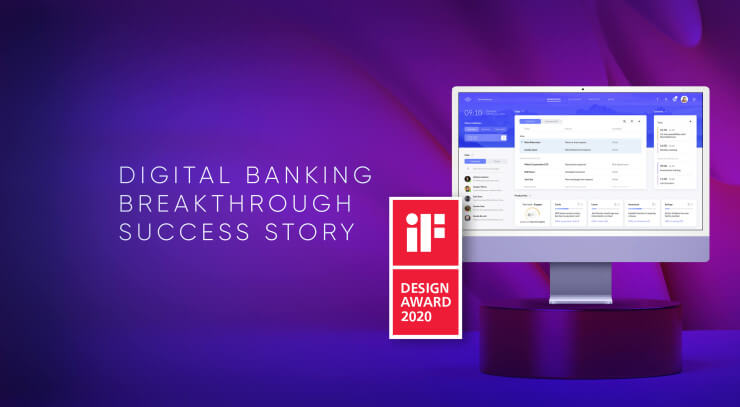Integrating AI into banking services will obviously revolutionize the user experience in financial services, offering real-time advice and 24/7 transaction monitoring. However, this shift not only enhances user experience but also addresses critical data privacy concerns. Unlike traditional cloud-based AI, on-device AI, as introduced by Apple, processes data locally, ensuring greater security and reducing latency. For financial institutions, the adoption of on-device AI presents a promising solution to deliver secure, efficient and highly personalized banking experiences.
Financial executives today face a critical conflict: the need to balance the security and efficiency of banking services with ever-increasing customer expectations for personalized and instantaneous financial insights provided by AI. From a user experience (UX) standpoint, embedding AI directly into banking apps could transform how users interact with financial services. Interest in the topic is extremely high, as evidenced by my Forbes article, “The Future of AI in Banking,” which received over 50,000 views.
Consider the role of a personal financial advisor. Traditionally, the role involves periodic meetings and delayed responses due to human scheduling and processing. With on-device AI, banks can offer real-time financial advice and transaction monitoring, creating a virtual 24/7 financial advisor.
Perhaps the biggest barrier for mass adoption of AI today, particularly in finance, is data privacy. Traditional cloud-based AI solutions, such as ChatGPT, while powerful, fall short in providing instant real-time responses and maintaining data privacy, both of which are crucial in the financial sector. For instance, no one knows exactly how Open AI uses your ChatGPT conversations and where else this data may be used.
Apple Answers to AI Privacy Threat
The future industry challenge is to offer a seamless, secure and personalized banking experience without compromising speed or user data security.
At Apple’s WWDC 2024 event, we were introduced to on-device AI (Apple Intelligence), that aimed to become a personalized AI advisor helping to perform and even predict everyday tasks on the iPhone. This is the first step toward personalized AI advisors that provide a contextual experience ─ and quite a significant one ─ because it provides a solution for data security issues: on-device AI.
Unlike cloud-based AI, on-device AI processes data directly on the user's device, drastically reducing latency and improving the speed of interactions. Apple’s new AI features in iOS 18 will operate entirely on the device, bypassing the need for cloud servers, thereby enhancing the user experience by eliminating connectivity issues and lag times.
Of course, it requires powerful hardware, so it will be available only on the latest Apple devices. As we know, the main focus of Apple has always been the user experience, this time the most private and personalized AI experience. And this is a great example of UX-centered innovation.
Apple Intelligence introduces advanced generative AI for the iPhone, iPad and Mac, integrating with iOS 18, iPadOS 18 and macOS Sequoia. The first key features will include:
- Writing Tools: Rewrite, proofread and summarize text in various apps.
- Mail Enhancements: Priority Messages, email summaries and Smart Reply.
- Notification Management: Priority Notifications and Reduce Interruptions Focus.
- Audio Tools: Record, transcribe and summarize calls.
- Image Playground: Create images in Animation, Illustration or Sketch styles.
- Genmoji Creation: Generate custom emojis from descriptions or photos.
- Siri Improvements: Enhanced natural language understanding and integration with ChatGPT.
Contrary to the conventional reliance on cloud computing, on-device AI offers a paradigm shift. This technology enables data processing directly on users' devices, drastically reducing latency, enhancing privacy and improving the overall user experience. According to Qualcomm, on-device AI not only accelerates performance but also ensures that personal data remains solely on the device, mitigating the risk of security breaches.
The Pros and Cons of On-Device AI vs. Cloud-Based AI
For financial UX experts, the main question is which AI will serve banking first ─ on-device AI or cloud-based AI?
The integration of on-device AI will represent a fundamental shift in how financial services can be delivered, blending the immediacy and personalization that modern users demand with the security and efficiency that banks require.
By embracing on-device AI, banks have a unique opportunity to redefine embedded banking services. This technology not only addresses the pressing concerns of security and speed but also enhances the user experience by providing personalized, real-time financial advice. However, there are also some challenges. Let’s compare cloud-based AI with on-device AI for banking.
Banking Cloud-Based AI Advisors
Pros
- Centralized Control and Consistency. Banking apps are connected to a centralized platform on which AI advisors can be uniformly deployed. This ensures consistency in service quality and allows banks to maintain control over AI's functionalities and updates. The app-based model can facilitate a seamless integration with existing financial products and services, offering users a cohesive experience.
- Enhanced Data Aggregation. AI advisors within banking apps can leverage comprehensive data from various financial accounts and third party services, providing holistic insights and personalized advice. By aggregating data from savings, investments and loans, AI can offer tailored financial plans that reflect the user's entire financial landscape.
- Improved Customer Interaction. In-app AI advisors can enhance customer interaction through real-time support, personalized notifications and proactive financial advice. This continuous engagement can improve customer satisfaction and loyalty, fostering a deeper relationship between the bank and its clients.
Cons
- Data Privacy Concerns. Centralized data processing in banking apps raises concerns about data privacy and security. Users may be wary of sharing sensitive financial information, fearing potential breaches or misuse.
- Dependence on Internet Connectivity. Banking app AI advisors typically require internet connectivity to function effectively, which can be problematic in areas with poor network coverage.
On-Device AI Advisors (Apple AI)
Pros
- Enhanced Privacy and Security. On-device AI, like Apple AI, processes data locally on the user's device, significantly reducing the risk of data breaches. This approach aligns with increasing consumer demand for privacy, as sensitive financial information remains on the device rather than being transmitted to cloud servers.
- Reduced Latency. By processing data on the device, on-device AI can provide real-time responses without the delays associated with cloud-based processing. This immediate interaction can enhance the user experience, making financial management more efficient and responsive.
- Integration with Device Ecosystem. On-device AI can seamlessly integrate with other device functionalities, such as personal assistants (e.g., Siri), health apps and calendar services. This integration allows for a more comprehensive personal assistant that can offer financial advice based on a broader understanding of the user's lifestyle and habits.
Cons
- Limited Data Scope. On-device banking AI may have limited access to comprehensive financial data compared to centralized banking apps. This can restrict AI's ability to provide holistic financial advice based on the user's entire financial portfolio.
- Device Compatibility and Performance. The effectiveness of on-device AI depends on the device's hardware capabilities. Older devices may struggle to support advanced AI functionalities, leading to a fragmented user experience.
How On-Device AI Could Empower Banks
On-device AI has a pretty high likelihood of being massively adopted soon in financial services for several reasons:
- Technological Maturity. With companies like Apple already embedding advanced AI capabilities in their devices, the infrastructure for on-device AI is ready and available now.
- User Privacy Concerns. The increasing importance of data privacy makes on-device AI an appealing choice for consumers and regulators alike.
- Strategic Industry Trends. The tech industry's shift toward decentralization and the strong push by leading tech firms suggest that on-device AI will gain traction very quickly.
This innovative shift to local processing not only accelerates user interactions but also bolsters privacy and security—a critical concern in financial services. By maintaining data on the device, banks can significantly reduce the risk of data breaches during transmission. This is particularly relevant in light of increasing sophistication in cyber threats that target financial data stored on cloud servers.
Moreover, the psychological impact of such immediate and personalized interactions cannot be underestimated. Users feel more in control and secure when they know their data is handled locally and not transmitted across potentially vulnerable networks. This trust is crucial for customer retention and satisfaction in banking services.
However, the benefits of on-device AI in banking extend far beyond security. On-device AI can create deeply personalized banking experiences. For example, Apple's Personal Voice feature, which generates customized voice responses on the user's device, demonstrates the potential for highly tailored interactions in banking applications. Imagine a banking assistant that not only understands your unique financial habits but also anticipates your needs and offers tailored advice in real time without compromising your data.
On-Device AI Brings Next-Gen Embedded Banking UX
Banks can leverage on-device AI to offer seamless and secure embedded banking services integrated into everyday digital interactions.
- Real-Time Financial Advisory. AI analyzes the user’s spending patterns, savings goals and investment portfolio in real time to provide suggestions tailored to the individual user.
- Instant Fraud Detection and Response. While making a purchase, AI detects an unusual transaction and immediately notifies the user through a conversational interface, asking for confirmation to proceed or flagging it as potential fraud.
- Voice-Activated Banking Assistant. A user utilizes voice commands to review account balances, transfer money and pay bills via the on-device AI assistant, which understands natural language and context.
- Contextual Financial Insights. The AI widget provides contextual insights based on the user’s location and activities. For example, if the user is traveling, it offers tips on currency exchange rates, local spending trends and nearby ATMs with lower fees.
- Budget Management and Savings Automation. AI monitors the user’s spending habits and automatically transfers surplus funds to a savings account or adjusts the budget to meet their savings goals.
- Personalization at Scale. On-device AI can analyze user behavior and preferences, enabling banks to offer tailored products and proactive alerts. For instance, AI can predict when a user might need a loan based on their spending patterns and offer it at the most opportune moment.
- Improved Security. By keeping data processing local, on-device AI significantly reduces the risk of data breaches. This is crucial in building and maintaining customer trust.
- Cost Efficiency. On-device processing minimizes the need for extensive cloud infrastructure, thereby reducing operational costs. Banks can then reinvest these savings into further technological advancements, enhancing their service offerings.
- Regulatory Compliance. Localized data processing helps banks more effectively comply with stringent data protection regulations, such as GDPR. This can simplify compliance processes and reduce the risk of regulatory penalties.
Conclusion: A Hybrid AI Approach in Banking
While both cloud-based and on-device financial AI advisors offer significant benefits, they have some cons. That’s why a hybrid approach may provide the most comprehensive solution.
By leveraging the strengths of both models, banks can deliver personalized, secure and efficient financial services. For instance, basic financial advice and routine interactions can be handled by on-device AI to ensure privacy and speed, while more complex financial planning and data aggregation can be managed by the banking app.
Adopting such a hybrid model not only addresses the limitations of each approach but also enhances user trust and engagement by offering a balanced combination of privacy, security and comprehensive financial management. As the financial industry continues to evolve, the integration of personal AI advisors through a hybrid approach could set the standard for next-generation banking services.
From a UX perspective, integrating on-device AI into banking interfaces taps into fundamental aspects of user psychology. Users seek autonomy, convenience and a sense of control over their financial activities. On-device AI can streamline the user journey, reducing friction points that traditionally plague online banking. For instance, AI-powered fraud detection and transaction monitoring can operate seamlessly in the background, alerting users only when necessary and allowing for swift, confident decision-making.
Moreover, AI's capability to learn from user behavior means that banking apps can evolve to meet individual preferences, making the experience not only efficient but also enjoyable.
The adoption of on-device AI is not just a tech upgrade; it requires a paradigm shift. The financial industry must recognize the transformative potential of this technology to enhance security, boost efficiency and, most importantly, create a superior user experience. By embracing on-device AI, any financial brand can be positioned at the forefront of digital innovation, ensuring it meets the evolving needs of digital customers while maintaining the highest standards of security and privacy.
Get UXDA Research-Based White Paper "How to Win the Hearts of Digital Customers":
 If you want to create next-gen financial products to receive an exceptional competitive advantage in the digital age, contact us! With the power of financial UX design, we can help you turn your business into a beloved financial brand with a strong emotional connection with your clients, resulting in success, demand, and long-term customer loyalty.
If you want to create next-gen financial products to receive an exceptional competitive advantage in the digital age, contact us! With the power of financial UX design, we can help you turn your business into a beloved financial brand with a strong emotional connection with your clients, resulting in success, demand, and long-term customer loyalty.
- E-mail us at info@theuxda.com
- Chat with us in Whatsapp
- Send a direct message to UXDA's CEO Alex Kreger on Linkedin






















